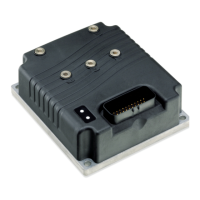76
Curtis 1222 Manual, os 15
2 9 J A N U A R Y 2 0 1 3 D R A F T
5 — COMMISSIONING
2
Command Map setup (see page 31)
The fourteen parameters in the Command Map menu define an 8-point map,
as described on page 31. The input to the Command Map (in units of %) can
be observed in Monitor » Command Input » Steer Command. The output to the
Command Map (in units of degrees) can be observed in Monitor » Command
Input » Steer Command (deg).
The Left Stop (deg) parameter is paired with a value of -100%, and the Right
Stop (deg) parameter is paired with a value of 100%. The P1-P6 Output values fill
in the continuum between the two stops; these values should get positive when
center is crossed. Similarly, the P1-P6 Input parameters should start with negative
percent values and increase to positive percent values. The settings of the point
pairs can be customized to shape the map according to the needs of the applica-
tion. In general, starting with a linear command map without any deadband is
recommended for vehicles that have the steered wheel in the center.
Setting the Left Stop (deg) and Right Stop (deg) to the correct angle is critical to
the setup of the vehicle as these two parameters set the maximum steering angle.
They must be set before continuing on to set up the position feedback.
Although any map shape can be set up, it is recommended that the map
always be set so that a Steer Command of zero equals a Steer Command (deg) of
zero. This is necessary to ensure that the auto-center functions work correctly,
and will aid in system troubleshooting.
Setting the parameters Left Stop (deg) to -180° and Right Stop (deg) to 180°
results in true 360° steering (also known as “round and round” steering). This
means the steered wheel will not have end stops and a command change from
-175° to 175° will cause the steered wheel to travel 10° clockwise rather than
350° counterclockwise. True 360° steering is compatible with all command
input devices except Type 0 - Analog1 and 3.
3
Command Input Device setup (see pages 20–22)
Your steering command input device will be a dual potentiometer or a sine/cosine
sensor or sawtooth sensor (using pins J1-8 and J1-19) or a dual encoder (using
pins J1-14, J1-25, J1-33, and J1-20). Most applications will have a primary
command input device and a supervisory command input device.
Set the Command Input Device parameter and the Supervision Input Device
parameter to the type of input you will be using:
Command Input Device Types Supervision Input Device Types
0 = Pot input 0 = Pot input
1 = Encoder input 1 = Encoder input
2 = Sin/Cos Sensor input 2 = Sin/Cos Sensor input
3 = Sawtooth Sensor input 3 = Sawtooth Sensor input
4 = CAN Sensor input 4 = CAN Sensor input
5 = None
Use the appropriate setup procedure for the devices, for the input you have
chosen for each. For applications with only a primary command input device,
you will need to set the Supervision Input Device parameter to 5.
☞
IMPORTANT
☞
IMPORTANT

